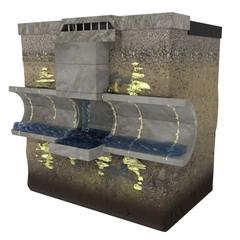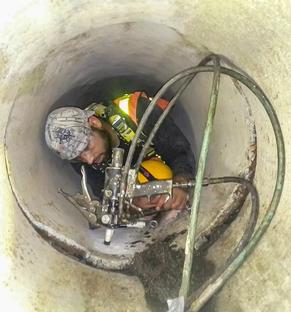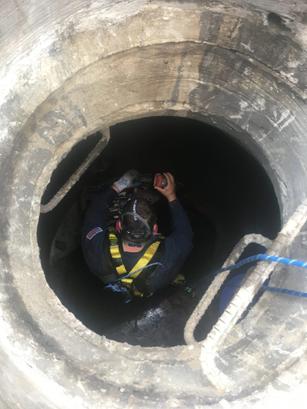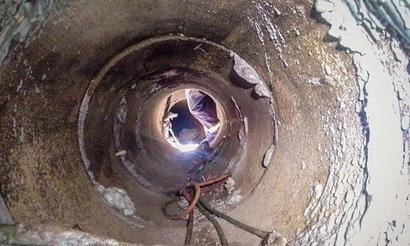Stabilize Failing Storm Systems
Stormwater systems are vulnerable to infiltration, erosion, and failure—especially where aging infrastructure meets unstable soils. When water escapes the system, it undermines the surrounding structure, creates surface depressions, and contributes to sinkholes and surface collapse. Our trenchless rehabilitation approach seals leaks and stabilizes soils around storm drains, inlets, and catch basins using structural polyurethane injection. It’s a fast, effective solution for municipalities and engineers seeking to extend system life without major disruption.
Schedule Your Consultation
What Is Stormwater System Rehabilitation?
Stormwater system rehabilitation restores the integrity of subgrade storm structures—such as inlets, catch basins, and outfall systems—by sealing active leaks and densifying the surrounding soils. The process involves injecting water-resistant polyurethane around the structure to stop infiltration and reestablish soil contact.
This method addresses both hydraulic inefficiencies and structural stability issues. In some cases, a polyurethane lining may be added internally to protect aging concrete, but injection remains the primary tool for sealing and soil restoration.
Where Might Stormwater Rehabilitation Be Needed?

- Around failing or leaking catch basins
- Inlets with visible joint separation
- Concrete structures in sandy or loose soils
- Systems showing signs of soil erosion
- Low-lying storm infrastructure in flood-prone areas
- Roadside drainage infrastructure near ponding zones
- Utility corridors where stormwater systems are collapsing
- Areas with chronic surface sinkholes or settlement
We Recommend Stormwater System Rehabilitation If You See:

- Inflow or infiltration at joints and seams
- Cracking in concrete vaults or risers
- Soil loss around the perimeter of the structure
- Standing water near access points or grates
- Pipe separation at the junction with the vault
- Surface sinking near storm drains or manholes
- Frequent flooding despite system capacity
- Undermining or erosion near outlet channels
- Repetitive emergency repairs in the same locations
- Sediment or debris in downstream piping
Is Stormwater System Rehabilitation Really Needed?

Yes. When storm structures leak or lose contact with surrounding soils, they no longer function as designed. Water escapes into the subgrade, causes erosion, and destabilizes the roadway or surface features above. Left untreated, the cost of full replacement and emergency response quickly escalates.
Our injection-based rehabilitation method stabilizes from the outside in—sealing joints, filling voids, and restoring function without excavation or system bypass. It’s a reliable option for extending the life of public infrastructure assets.
What Are the Advantages of Stormwater System Rehabilitation?
This approach solves both hydraulic and structural problems with minimal surface impact.
Seals Active Leaks: Stops infiltration and restores hydraulic integrity.
Stabilizes Surrounding Soil: Prevents erosion and soil migration.
Preserves Existing Infrastructure: Avoids costly removal and replacement.
Trenchless and Fast: Requires no excavation or bypass piping.
Works in Wet Conditions: Ideal for active systems and high water tables.
Common Problem Areas
- Catch basins and inlets in older developments
- Roadside drainage near storm vaults
- Stormwater outfalls in sandy soils
- Low-lying access structures in retention zones
- Vaults and risers in flood-prone areas
- Urban infrastructure with shallow pipe networks
Protect Your Stormwater Infrastructure with Groundworks’ Targeted Rehabilitation Solutions.
How Does Stormwater System Rehabilitation Work?
A trenchless injection process that reinforces aging storm structures and the soils around them.
- Inspect structure for leakage and erosion using visual or CCTV
- Identify failure points and subgrade risks
- Drill small-diameter ports near structure or from surface
- Inject hydrophobic polyurethane into bedding or backfill
- Foam expands, seals leak paths, and compacts adjacent soils
- Monitor for movement or signs of continued leakage
- Optional polyurethane lining added if interior degradation is present
- Restore access and provide detailed reporting
Why This Is the Best Choice

- No excavation or traffic rerouting
- Prevents sinkholes and surface collapse
- Effective on precast or cast-in-place structures
- Compatible with wet, active storm systems
- Ideal for municipal or DOT infrastructure
- Long-lasting solution that resists groundwater
- Scalable from single inlets to full corridors
- Supports long-term asset management planning
Contact Groundworks for Stormwater Rehabilitation
Stormwater System Rehabilitation
Groundworks provides trenchless rehabilitation services that stop infiltration, stabilize surrounding soils, and restore the performance of stormwater systems. Our polyurethane injection method is trusted by municipalities and engineers alike for fast, lasting results. Contact us today for a site assessment.
Names You Know Trust Groundworks with Their Toughest Foundation Issues





We want to learn about your project.
FAQs
Yes. All work is trenchless and performed externally or through minor access ports.
Yes. Injection addresses infiltration while restoring soil support around the structure.
Yes. Hydrophobic polyurethane is ideal for active, saturated environments.
Once cured, the material forms a durable, water-insensitive bond that resists degradation.
Yes. Injection stabilizes the outside, and lining can later protect the interior if needed.
Disclaimer / Terminology
Stormwater Rehabilitation: Process of restoring the function and stability of drainage infrastructure.
Hydrophobic Polyurethane: Expanding resin that cures in wet conditions and seals leaks.
Catch Basin / Inlet: Subgrade storm structures that collect and route runoff.
Polyurethane Lining: Internal coating applied for surface protection if needed.
Infiltration: Groundwater entering a structure due to joint failure or cracks.